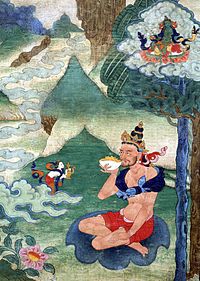Six Yogas of Naropa
The Six Yogas of Nāropa (T. na ro chos drug ན་རོ་ཆོས་དྲུག), also called the "Six Dharmas of Naropa," are a set of tantric practices in Tibetan Buddhism attributed to the the Indian mahasiddha Nāropa. Naropa transmitted these practices to the Tibetan translator-yogi Marpa. Marpa in turn brought these practices back to Tibet and transmitted them to his students there. His most prominent student was the great yogi Milarepa.
The six yogas are fundamental to the meditative training of the Kagyu school.[1] They are also practiced by the other schools of Tibetan Buddhism.
The six practices
- inner heat (tummo; T. gtum mo གཏུམ་མོ་; Skt. caṇḍālī) – entails the manipulation of the subtle energy of the body, which produces states of bliss and clarity, as well as physical warmth
- illusory body (gyulü; T sgyu lus སྒྱུ་ལུས; Skt. māyākāyā) – entails realizing the illusory nature of ordinary experience
- clear light (ösel; T od gsal འོད་གསལ་; Skt. prabhasvara) – entails recognizing the luminous aspect of mind
- dream (milam; T. rmi lam རྨི་ལམ་; Skt: svapna[-darśana]) – developing conscious awareness in the dream state
- transference (phowa; T. pho ba འཕོ་བ་; Skt: saṃkrānti) – directing transference of consciousness at the time of death, for either oneself or another
- intermediate state (bardo; T. bar do བར་དོ་; Skt: antarābhava) – entails maintaining awareness during the intermediate state (bardo) between the death of one lifetime and rebirth into the next lifetime.
Six yogas of Niguma
The "six yogas of Niguma" are almost identical to the six yogas of Nāropa. These practices are attributed to Niguma, who was closely associated with Nāropa.[4] Niguma transmitted her teachings to the yogini Sukhasiddhī and then to Khyungpu Neldjor, the founder of the Shangpa Kagyu lineage.
The 2nd Dalai Lama compiled a work on these yogas.[5]
Notes
- ↑ 1.0 1.1 Buswell & Lopez 2014, s.v. Nā ro chos drug.
- ↑ Traleg Kyabgon 2020, Chapter 10: Overview of the Six Yogas of Naropa.
- ↑
 na_ro_chos_drug, Rangjung Yeshe Wiki
na_ro_chos_drug, Rangjung Yeshe Wiki
- ↑ Differing accounts portray Niguma as Naropa's sister of wife.
- ↑ 2nd Dalai Lama. Tantric Yogas of Sister Niguma, Snow Lion Publications, 1st ed. U. edition (May 1985), ISBN 0-937938-28-9 (10), ISBN 978-0-937938-28-7 (13)
Sources
 Buswell, Robert E.; Lopez, Donald S. (2014), The Princeton Dictionary of Buddhism, Princeton University
Buswell, Robert E.; Lopez, Donald S. (2014), The Princeton Dictionary of Buddhism, Princeton University- Harding, Lama Sarah (2012) Niguma, Lady of Illusion (Tsadra Foundation). Ithaca: Snow Lion Publications. ISBN 978-1559393614
- Traleg Kyabgon (2020), Vajrayana: An Essential Guide to Practice, Shogam Publications
Further reading
- Baker, Ian (2019), Tibetan Yoga: Principles and Practices, Inner Traditions
- Garma C.C. Chang (1986), The Six Yogas of Naropa, Snow Lion
- Kragh, Ulrich Timme (2015) Tibetan Yoga and Mysticism A Textual Study of the Yogas of Naropa and Mahamudra Meditation in the Medieval Tradition of Dags po. Tokyo: International Institute for Buddhist Studies (Studia Philologica Buddhica). ISBN 4-90626-772-6
- Mullin, Glenn H. (2006), The Practice of the Six Yogas of Naropa, Snow Lion, ISBN 978-1559392563
- Mullin, Glenn H.; Tsong-Kha-Pa, (2005) The Six Yogas Of Naropa, Tsongkhapa's Commentary, Snow Lion Publications. ISBN 1-55939-234-7
- Mullin, Glenn H. (1997) Readings on the Six Yogas of Naropa, Snow Lion Publications. ISBN 1-55939-074-3
- Roberts, Peter Alan (2011), Mahamudra and Related Instructions, Somerville, MA: Wisdom Publications
 Six Dharmas of Naropa, Wikipedia
Six Dharmas of Naropa, Wikipedia
